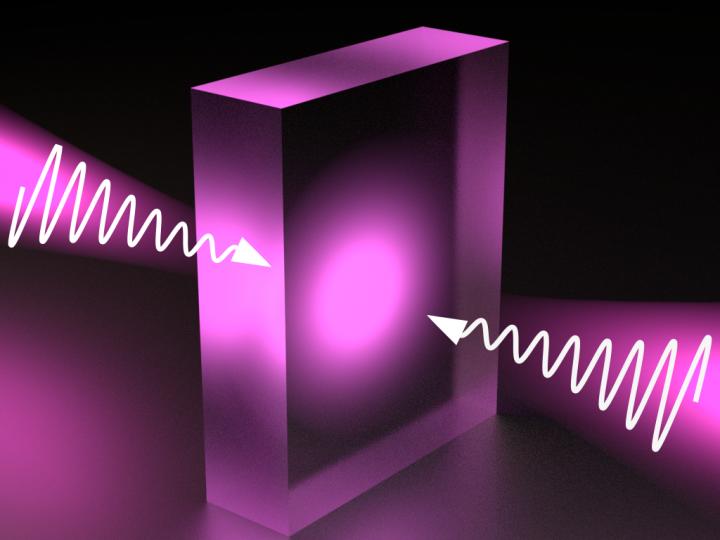Scientists make transparent materials absorb light

This is a schematic of a virtual light absorption process: A layer of a transparent material is exposed to light beams from both sides, with the light intensity increasing in time. Image courtesy of the researchers. Credit: MIPT Press Office
The absorption of electromagnetic radiation — light, among other things — is one of the main effects of electromagnetism. This process takes place when electromagnetic energy is converted to heat or another kind of energy within an absorbing material (for instance, during electron excitation).
Coal, black paint, and carbon nanotube arrays — also known as Vantablack — look black because they absorb the energy of the incident light almost completely. Other materials, such as glass or quartz, have no absorbing properties and therefore look transparent.
In their theoretical research, the results of which were published in the journal Optica, the physicists managed to dispel that simple and intuitive notion by making a completely transparent material appear perfectly absorbing. To achieve that, the researchers employed special mathematical properties of the scattering matrix — a function that relates an incident electromagnetic field with the one scattered by the system.
When a light beam of time-independent intensity hits a transparent object, the light does not get absorbed but is scattered by the material — a phenomenon caused by the unitary property of the scattering matrix. It turned out, however, that if the intensity of the incident beam is varied with time in a certain fashion, the unitary property can be disrupted, at least for some time. In particular, if the intensity growth is exponential, the total incident light energy will accumulate in the transparent material without leaving it (fig. 1). That being the case, the system will appear perfectly absorbing from the outside.
To illustrate the effect, the researchers examined a thin layer of a transparent dielectric and calculated the intensity profile required for the absorption of the incident light. The calculations confirmed that when the incident wave intensity grows exponentially (the dotted line on fig. 2), the light is neither transmitted nor reflected (the solid curve on fig. 2). That is, the layer looks perfectly absorbing despite the fact that it lacks the actual absorption capacity. However, when the exponential growth of the incident wave amplitude comes to a halt (at t = 0), the energy locked in the layer is released.
“Our theoretical findings appear to be rather counterintuitive. Up until we started our research, we couldn't even imagine that it would be possible to 'pull off such a trick' with a transparent structure,” says Denis Baranov, a doctoral student at MIPT and one of the authors of the study. “However, it was the mathematics that led us to the effect. Who knows, electrodynamics may well harbor other fascinating phenomena.”
The results of the study not only broaden our general understanding of how light behaves when it interacts with common transparent materials, but also have a wide range of practical applications. To give an example, the accumulation of light in a transparent material may help design optical memory devices that would store optical information without any losses and release it when needed.
Media Contact
All latest news from the category: Physics and Astronomy
This area deals with the fundamental laws and building blocks of nature and how they interact, the properties and the behavior of matter, and research into space and time and their structures.
innovations-report provides in-depth reports and articles on subjects such as astrophysics, laser technologies, nuclear, quantum, particle and solid-state physics, nanotechnologies, planetary research and findings (Mars, Venus) and developments related to the Hubble Telescope.
Newest articles

A ‘language’ for ML models to predict nanopore properties
A large number of 2D materials like graphene can have nanopores – small holes formed by missing atoms through which foreign substances can pass. The properties of these nanopores dictate many…

Clinically validated, wearable ultrasound patch
… for continuous blood pressure monitoring. A team of researchers at the University of California San Diego has developed a new and improved wearable ultrasound patch for continuous and noninvasive…

A new puzzle piece for string theory research
Dr. Ksenia Fedosova from the Cluster of Excellence Mathematics Münster, along with an international research team, has proven a conjecture in string theory that physicists had proposed regarding certain equations….



